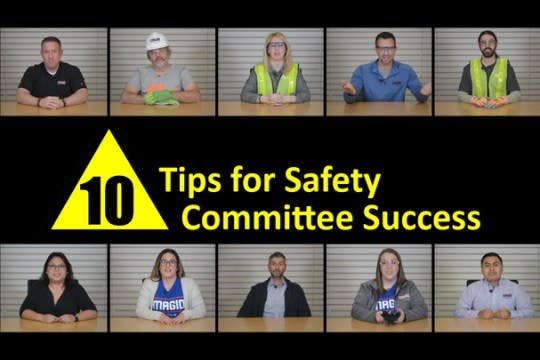
10 Safety Committee Ideas for Better Results
Most Safety Managers know that safety committees are a good idea, and many states actually require them by law. But is your committee doing all it can and should be doing? If you answered No, you’re not alone. A poll by Safety & Health Magazine found that only 32.6% of their readers said their safety committees were effective.
Here are our top 10 ideas to start improving today!

1. Review Your Safety Committee Mission Statement & Purpose
The purpose of a safety committee is to regularly bring employees from all levels of your organization together to improve, communicate, and promote workplace safety. Make sure everyone on your committee:
- Understands their role
- Understands the importance of what they’re doing
- Feels empowered to make recommendations for improvements
Take some time at your next meeting to review and clarify your safety mission and goals.

2. Include the Right People in Your Safety Committee Meeting
An effective safety committee should be a representation of your company, including a mix of:
- management
- salaried employees
- hourly employees
- stakeholders from different departments
Having a good mix of viewpoints can reveal different ideas and opinions and helps you anticipate any potential resistance. Including managers helps you to get decisionmakers on board and bought in early for any new ideas.

3. Make Time for Safety Committee Meetings
Don't squeeze committee meetings into your schedule. Carve out time for safety meetings and commit to them. Whether it's the first Monday of the month or the last Friday of the quarter, pick a day and stick to it so everyone knows it's a time that's important to your goals and mission!

4. Let Others Drive the Meeting
As a safety expert, you may find it difficult to take a back seat in your safety meetings. Though it may sound a little strange, it’s important not to be too active. Instead, serve as a coach or as a resource to the group so members feel free to speak up and be creative. Your role should be more about coordinating management and supporting employees.

5. Conduct a Group Safety Audit
Ask your safety committee to review your documented safety processes and procedures as a group to determine if there's a clearer way to communicate safety policies to front-line workers. If you don't have documented safety procedures, start creating them! Splitting up areas or processes to document might be a good way to get a new safety committee off the ground.

6. Have Your Safety Committee Walk the Plant or Jobsite
Ask your entire safety committee to walk the plant floor or jobsite and note safer, more efficient ways to get the job done including things like signage recommendations, PPE suggestions, and lighting improvements. Include outside experts to fill in gaps that might exist in your committee's expertise like an ergonomist or a professional safety assessor.

7. Give Your Safety Training a Trial Run
Use your safety committee as an audience to test your safety training materials and solicit suggestions. Periodic training reviews help keep your information timely and accurate. Check out additional sources of safety training classes and materials to keep your library fresh and up to date.

8. Look for Blended Safety Training Opportunities
As a group, brainstorm ways you might start to combine two or more forms of delivering information—for example, a combination of classroom instruction and an independent, self-paced online course. A University of Tennessee study showed that a blended learning program reduced both the time and the cost of training by more than 50%. The same study showed a 10% better result in learning outcomes compared with traditional training. You can even introduce fun safety training videos to help certain lessons stick.

9. Create a Safety Reward Program
Since you’ll have a mix of front-line workers and experienced managers in the same room, work together to create a rewards program that will motivate your employees and spark enthusiasm while helping to reduce injuries. Rewards can range from free PPE gear to paid days off to gift cards and even lottery tickets.

10. Keep Ideas Fresh
Once you've tapped the safety committee for their ideas and suggestions, consider rotating members. This opens your committee up for new viewpoints and experiences on an ongoing basis.
Remember to review this Top 10 periodically to avoid stagnation. Keeping ideas fresh is key to the kind of continued safety improvements that make your committee and your safety program effective now and for the long haul.
Download Safety Training Presentations to use in your next safety committee meeting!







